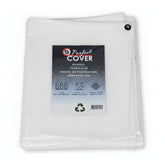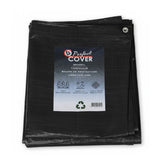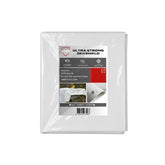1. Bescherming tegen weersinvloeden
Bij bouwprojecten wordt de voortgang vaak gehinderd door onvoorspelbare weersomstandigheden. Regen, wind, sneeuw en andere weerelementen kunnen niet alleen vertraging veroorzaken, maar ook ernstige schade aan materialen toebrengen, met extra kosten en oponthoud tot gevolg. In dit opzicht zijn dekzeilen van onschatbare waarde.
Regen is een van de grootste vijanden van bouwmaterialen. Blootstelling aan vocht kan hout doen uitzetten, gipsplaten doen kromtrekken en cement doen uitharden voordat het de kans krijgt goed te hechten. Door strategisch dekzeilen over bouwmaterialen en onafgewerkte constructies te plaatsen, ontstaat een waterdichte barrière die voorkomt dat regenwater binnendringt en schade veroorzaakt.
Dekzeilen beschermen daarnaast tegen harde wind. Wind kan losse materialen opwaaien en als projectielen rondwerpen, wat niet alleen gevaarlijk is voor werknemers, maar ook schade kan veroorzaken aan eigendommen en reeds afgewerkte onderdelen. Door dekzeilen stevig te bevestigen, wordt de windinwerking op de bouwplaats beperkt en worden risicovolle situaties voorkomen.
In koudere klimaten vormt sneeuw een extra uitdaging. Sneeuwophoping kan werkzaamheden op hoogte vertragen, terwijl smeltwater het risico op vochtproblemen vergroot. Strategisch geplaatste dekzeilen bieden bescherming tegen sneeuw en voorkomen dat smeltwater doordringt in onafgewerkte bouwelementen.
Naast regen, wind en sneeuw beschermen dekzeilen ook tegen fel zonlicht en extreme temperaturen. Overmatige zonnestraling kan materialen doen verkleuren, uitdrogen of beschadigen, terwijl temperatuurschommelingen de eigenschappen van bepaalde bouwmaterialen kunnen aantasten. Door dekzeilen te gebruiken als schaduwdoek of isolatielaag worden materialen en structuren beschermd tegen deze weersinvloeden.
Kortom: dekzeilen spelen een cruciale rol bij het beschermen tegen de elementen, zorgen voor een gestroomlijnd bouwproces en bewaken de kwaliteit van het werk. Hun veelzijdigheid en effectiviteit maken ze onmisbaar voor bouwprofessionals wereldwijd.
2. Vochtregulatie
Een van de grootste uitdagingen tijdens bouw- en renovatieprojecten is het beheersen van vocht. Vochtophoping in materialen en constructies kan leiden tot schimmelvorming, houtrot, corrosie en aantasting van de structurele integriteit. Een juiste installatie van dekzeilen is een doeltreffende methode om deze problemen aan te pakken en de levensduur van bouwprojecten te verlengen.
Dekzeilen fungeren als vochtbarrière en voorkomen dat regen, smeltwater, condens en andere vochtbronnen materialen binnendringen. Vooral tijdens de ruwbouwfase, wanneer een gebouw nog niet waterdicht is, is dit van essentieel belang. Denk aan het afdekken van daken, vloeren, muren of andere kwetsbare onderdelen.
Daarnaast helpen dekzeilen bij het reguleren van de luchtvochtigheid op de bouwplaats. Door vocht buiten te houden, neemt de kans op schimmelvorming af. Dit is met name belangrijk in vochtige klimaten of seizoenen.
Ook kunnen dekzeilen worden ingezet om vochtige zones af te bakenen en verdere verspreiding van vocht te voorkomen, bijvoorbeeld bij renovatieprojecten waar sprake is van lekkages.
Conclusie: door dekzeilen strategisch te gebruiken binnen een vochtbeheerplan, kunnen bouwprofessionals vochtgerelateerde problemen beperken en de duurzaamheid van hun werk waarborgen. Investeren in kwalitatieve dekzeilen en goed onderhoud levert aanzienlijke besparingen en klanttevredenheid op.
3. Bescherming van bouwmaterialen
Materialen zoals hout, cement, staal en gipsplaten zijn kwetsbaar voor vocht, mechanische schade en externe invloeden zoals stof, vuil en chemicaliën. Dekzeilen beschermen deze materialen gedurende het hele bouwproces – van levering op locatie tot oplevering.
Vocht is vaak de grootste boosdoener. Hout kan vervormen, cement kan vroegtijdig uitharden, staal kan roesten en gipsplaten kunnen opzwellen en onbruikbaar worden. Dekzeilen vormen een doeltreffende barrière tegen vocht, en beschermen materialen tegen regen, sneeuw en condensatie.
Naast vocht weren dekzeilen ook stof, vuil en chemische stoffen. Zo blijven de materialen schoon en intact, wat bijdraagt aan de kwaliteit van het eindresultaat.
Kortom: dekzeilen zijn essentieel voor het behoud van de kwaliteit van bouwmaterialen. Door tijdig en correct gebruik blijven materialen langer bruikbaar, wordt schade beperkt en dalen de herstel- en vervangingskosten.
4. Tijdelijke opslag
Op een bouwplaats is efficiëntie cruciaal. Vaak worden materialen in grote hoeveelheden geleverd, maar pas later gebruikt. Dekzeilen bieden een praktische oplossing voor tijdelijke opslag, met bescherming tegen weersinvloeden, diefstal en beschadiging.
Tijdelijke opslag op locatie biedt flexibiliteit. Materialen kunnen blijven liggen tot ze nodig zijn, wat transport- en logistiekkosten vermindert. Een dekzeil fungeert als beschermlaag tegen regen, sneeuw en wind, zodat materialen in optimale staat blijven.
Daarnaast helpt een afdekzeil bij diefstalpreventie. Afgedekte materialen vallen minder op en zijn minder toegankelijk, wat de veiligheid verhoogt.
Dekzeilen zijn bovendien aanpasbaar aan de vorm en grootte van de opgeslagen materialen – van grote houtpakketten tot kleinere gereedschappen.
Conclusie: het gebruik van dekzeilen voor tijdelijke opslag bevordert de efficiëntie, vermindert risico’s en verlengt de levensduur van materialen.
5. Flexibiliteit en aanpasbaarheid
Een van de grootste voordelen van dekzeilen is hun flexibiliteit. Ze zijn inzetbaar in uiteenlopende bouwomstandigheden en passen zich eenvoudig aan aan verschillende noden en locaties.
Dekzeilen zijn verkrijgbaar in diverse afmetingen – van kleine stukken tot grote oppervlakken – waardoor ze geschikt zijn voor het afdekken van zowel kleine materiaalstapels als volledige werkzones.
Ze zijn er ook in verschillende vormen, waaronder rechthoekig, driehoekig of rond. Hierdoor kunnen ze perfect afgestemd worden op de geometrie van de bouwplaats.
Daarnaast zijn ze beschikbaar in uiteenlopende materialen: van zwaar PVC tot lichtgewicht polyethyleen. Dit maakt het mogelijk om te kiezen op basis van duurzaamheid, weersbestendigheid of budget.
Verschillende bevestigingsopties – zoals ogen, haken, klittenband of elastieken – maken het makkelijk om dekzeilen stevig vast te zetten, zelfs bij harde wind of wisselende omstandigheden.
Kortom: dankzij hun aanpasbaarheid zijn dekzeilen een veelzijdig en kostenefficiënt hulpmiddel voor elk bouwproject, groot of klein.
6. Hergebruik
Een van de belangrijkste eigenschappen van hoogwaardige dekzeilen is hun herbruikbaarheid. Dit maakt ze tot een duurzame en kostenbesparende oplossing voor projecten van elke omvang.
Kwalitatieve dekzeilen worden gemaakt van sterke materialen die bestand zijn tegen UV-straling, extreme temperaturen en mechanische belasting. Hierdoor gaan ze lang mee en kunnen ze voor meerdere projecten worden ingezet zonder kwaliteitsverlies.
Het hergebruik van dekzeilen bespaart op de lange termijn aanzienlijk in de kosten. In plaats van telkens nieuwe exemplaren aan te schaffen, kunnen ze herhaaldelijk worden ingezet, wat leidt tot minder afval en een beter beheer van het projectbudget.
Bovendien draagt hergebruik bij aan een duurzamere bouwpraktijk. Minder afval betekent minder belasting voor het milieu – iets waar in de moderne bouwsector steeds meer waarde aan wordt gehecht.
Samengevat: herbruikbare dekzeilen zijn een waardevolle investering die bijdragen aan efficiëntie, duurzaamheid en kostenbesparing.
Slotboodschap
Dekzeilen zijn de stille kracht achter succesvolle bouwprojecten – beschermend, flexibel en duurzaam. Investeer vandaag nog in hoogwaardige dekzeilen van Avoid voor een efficiënte, veilige en kosteneffectieve bouwpraktijk.
Ontdek ons assortiment en ervaar hoe dekzeilen uw projecten naar een hoger niveau tillen.








